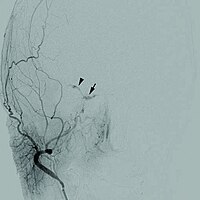
Photo from wikipedia
Objectives Patients with minor ischemic stroke (MIS) frequently suffer from early neurological deterioration (END) and become disabled. Our study aimed to explore the association between serum neurofilament light chain (sNfL)… Click to show full abstract
Objectives Patients with minor ischemic stroke (MIS) frequently suffer from early neurological deterioration (END) and become disabled. Our study aimed to explore the association between serum neurofilament light chain (sNfL) levels and END in patients with MIS. Methods We conducted a prospective observational study in patients with MIS [defined as a National Institutes of Health Stroke Scale (NIHSS) score 0–3] admitted within 24 h from the onset of symptoms. sNfL levels were measured at admission. The primary outcome was END, defined as an increase in the NIHSS score by ≥2 points within 5 days after admission. Univariate and multivariate analyses were performed to explore the risk factors associated with END. Stratified analyses and interaction tests were conducted to identify variables that might modify the association between sNfL levels and END. Results A total of 152 patients with MIS were enrolled, of which 24 (15.8%) developed END. The median sNfL level was 63.1 [interquartile range (IQR), 51.2–83.4] pg/ml on admission, which was significantly higher than that of 40 age- and sex-matched healthy controls (median 47.6, IQR 40.8–56.1 pg/ml; p < 0.001). Patients with MIS with END had a higher level of sNfL (with ND: median 74.1, IQR 59.5–89.8 pg/ml; without END: median 61.2, IQR 50.5–82.2 pg/ml; p = 0.026). After adjusting for age, baseline NIHSS score, and potential confounding factors in multivariate analyses, an elevated sNfL level (per 10 pg/mL) was associated with an increased risk of END [odds ratio (OR) 1.35, 95% confidence interval (CI) 1.04–1.77; p = 0.027). Stratified analyses and interaction tests demonstrated that the association between sNfL and END did not change by age group, sex, baseline NIHSS score, Fazekas' rating scale, hypertension, diabetes mellitus, intravenous thrombolysis, and dual antiplatelet therapy in patients with MIS (all p for interaction > 0.05). END was associated with an increased risk of unfavorable outcomes (modified Rankin scale score ranging from 3 to 6) at 3 months. Conclusion Early neurological deterioration is common in minor ischemic stroke and is associated with poor prognosis. The elevated sNfL level was associated with an increased risk of early neurological deterioration in patients with minor ischemic stroke. sNfL might be a promising biomarker candidate that can help to identify patients with minor ischemic stroke at high risk of neurological deterioration, for reaching individual therapeutic decisions in clinical practice.
Journal Title: Frontiers in Neurology
Year Published: 2023
Link to full text (if available)
Share on Social Media: Sign Up to like & get
recommendations!